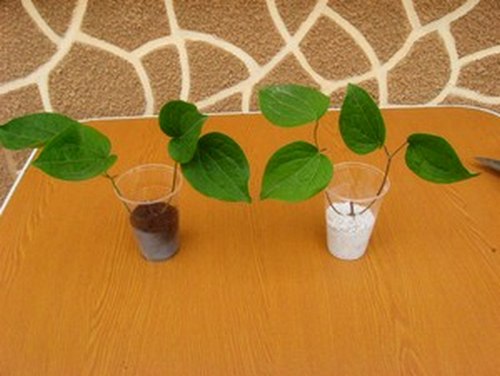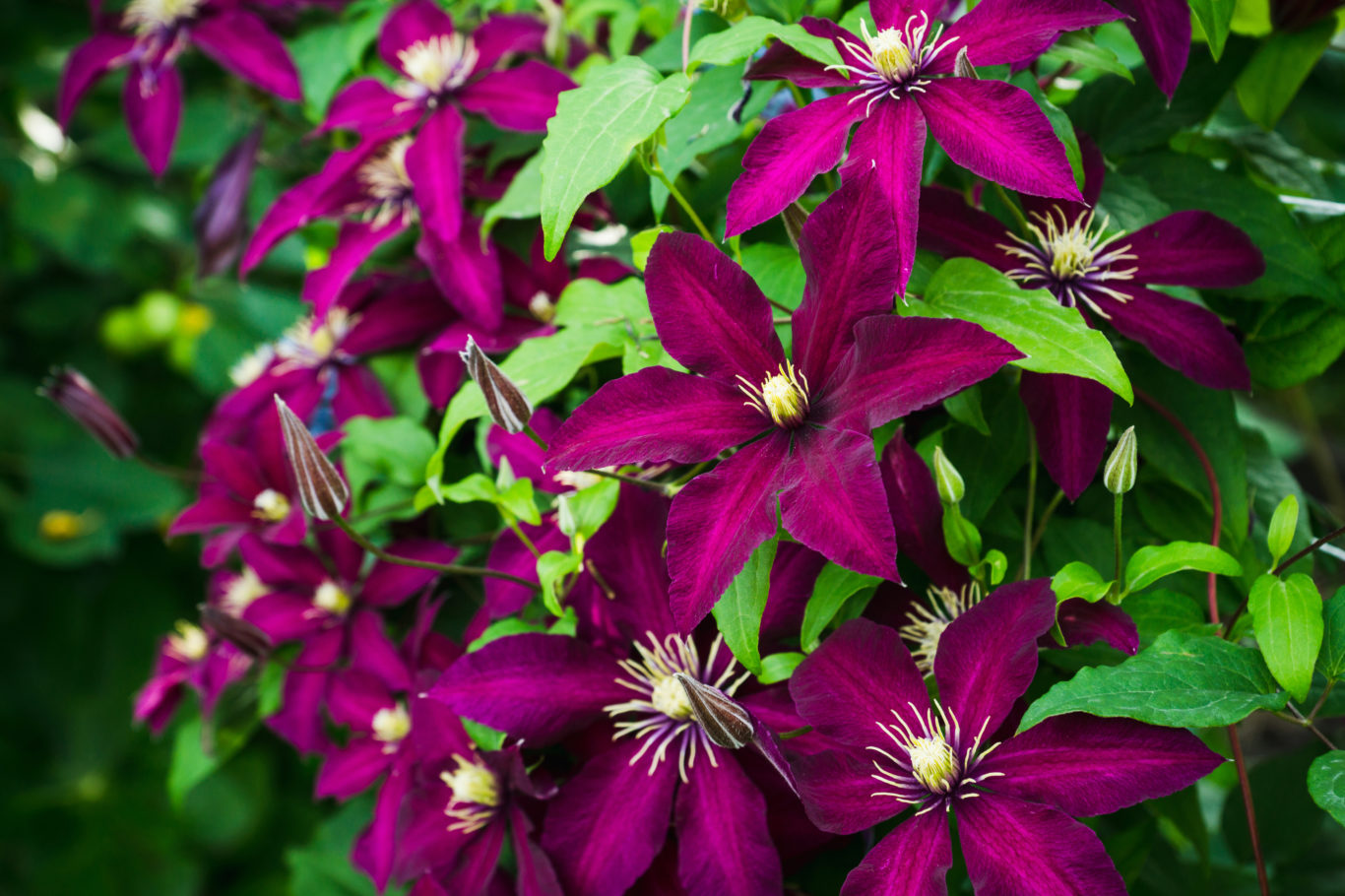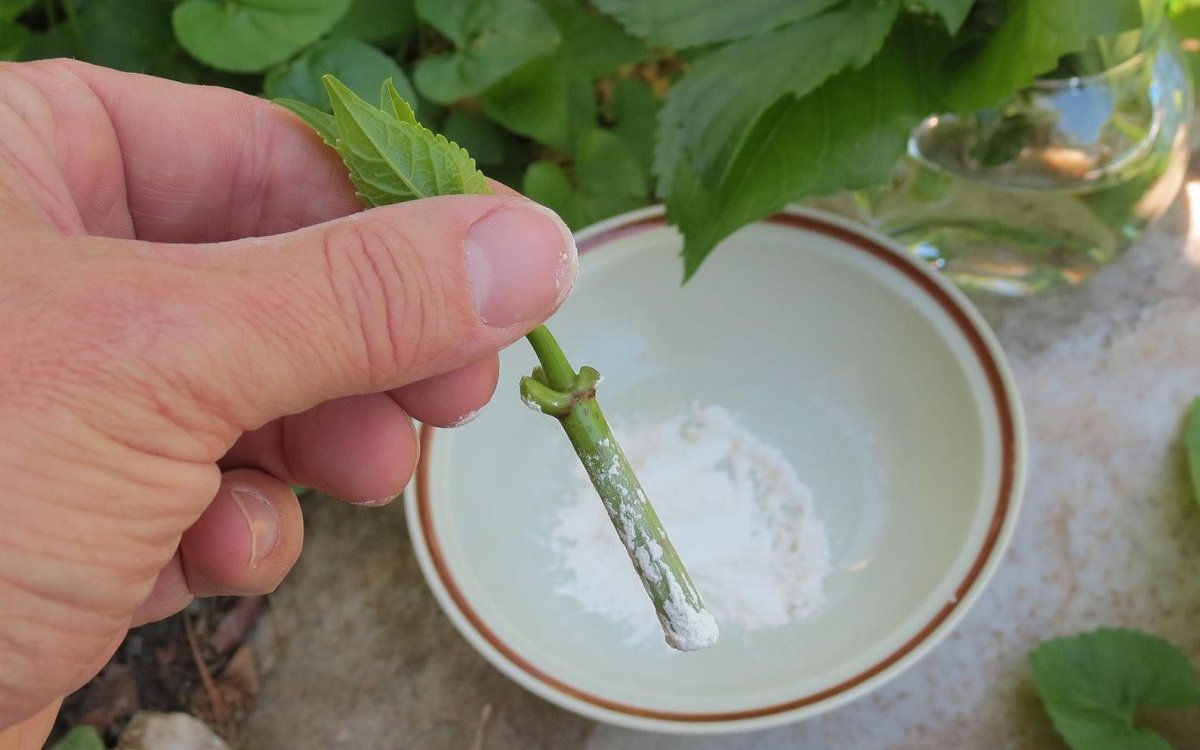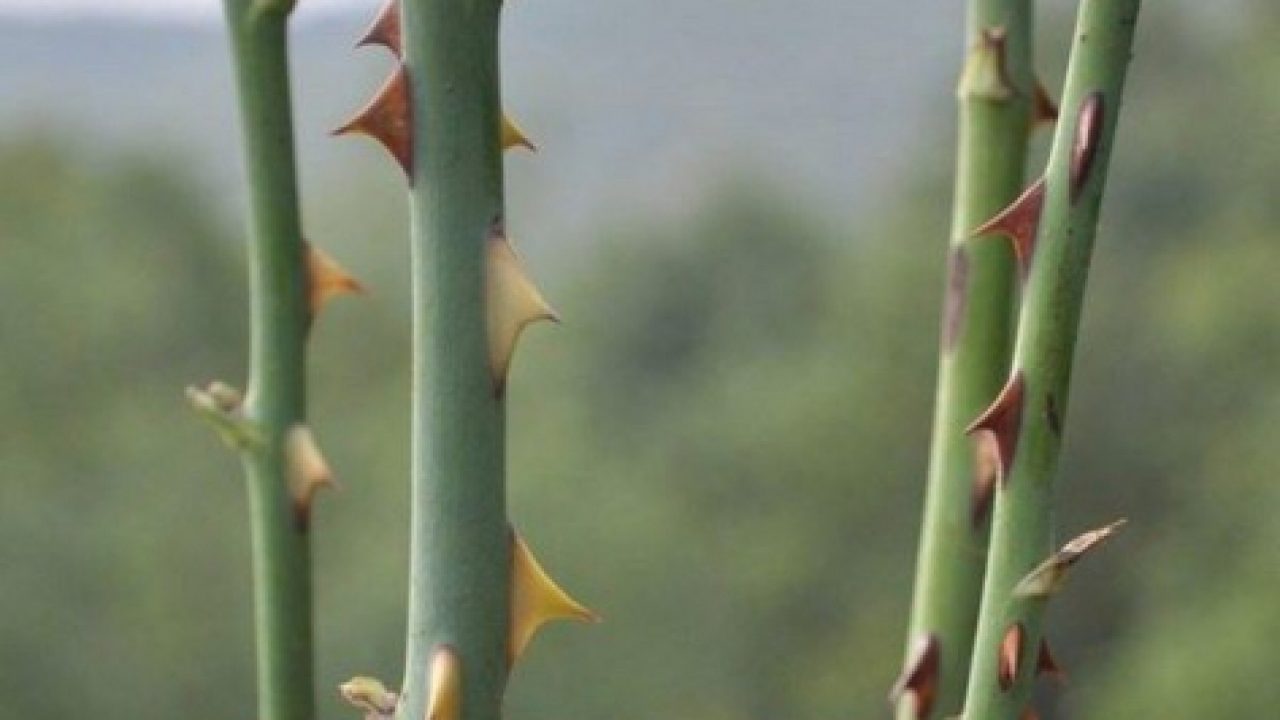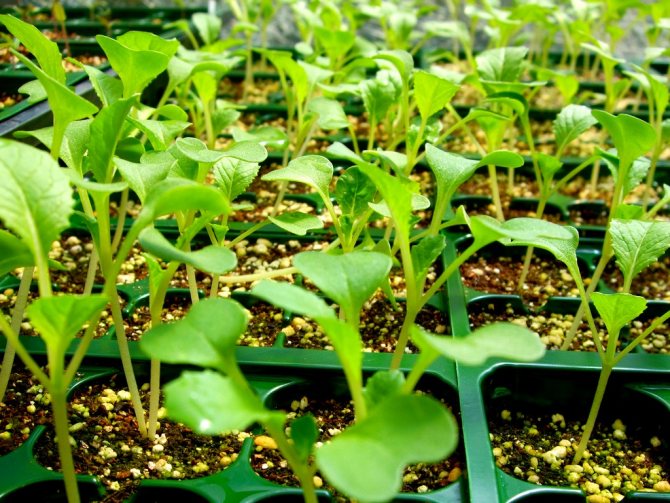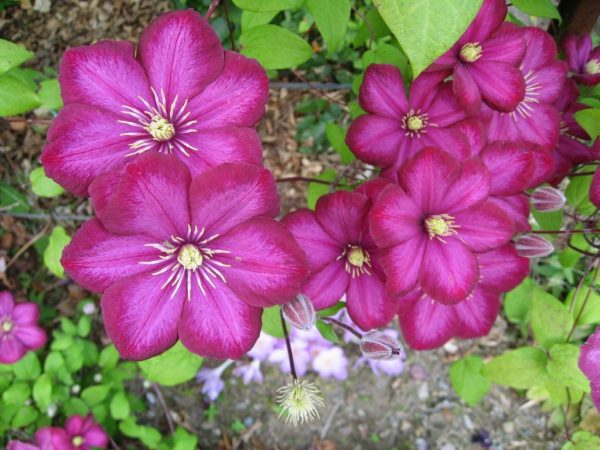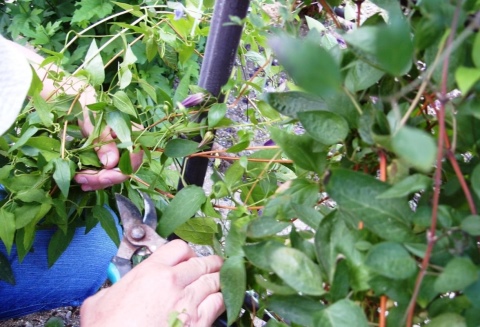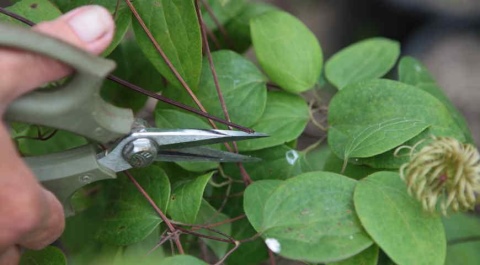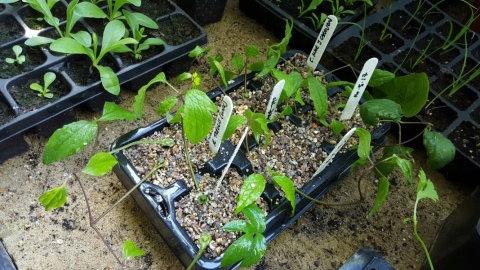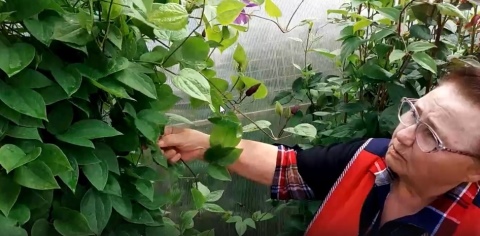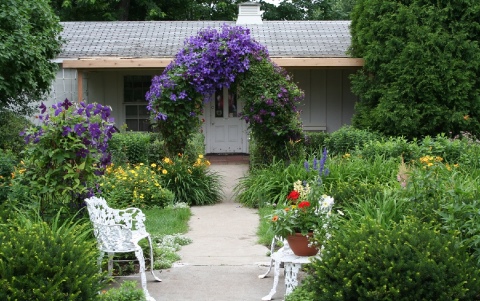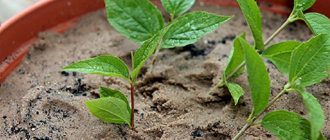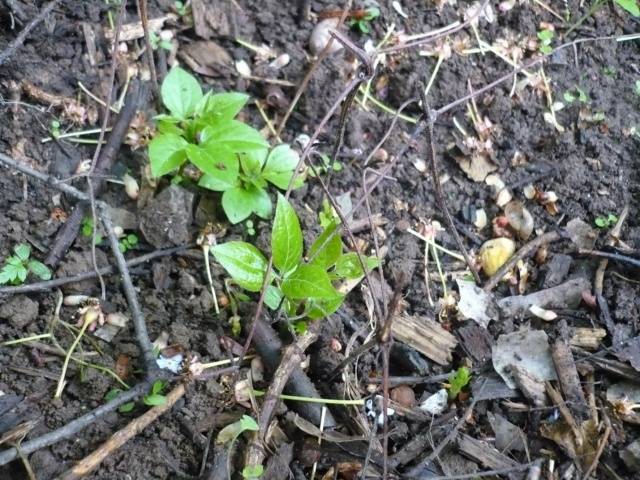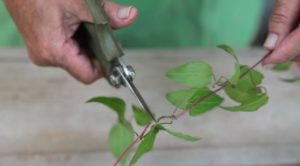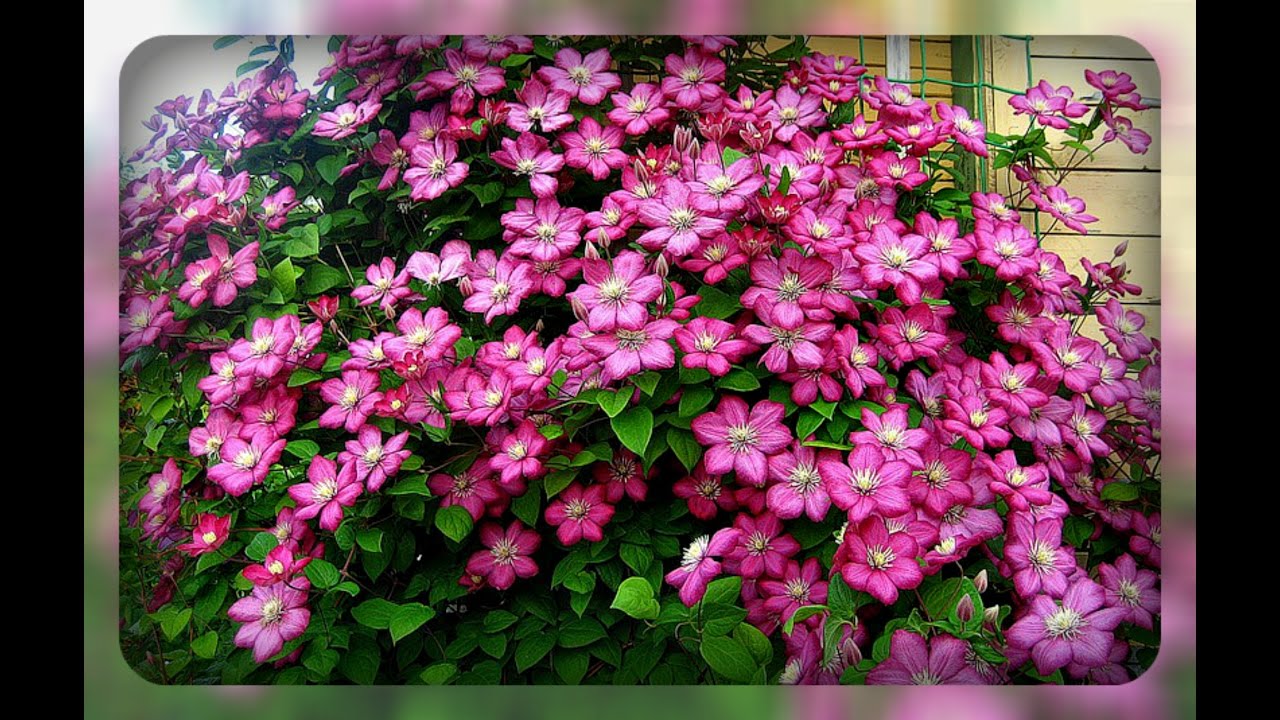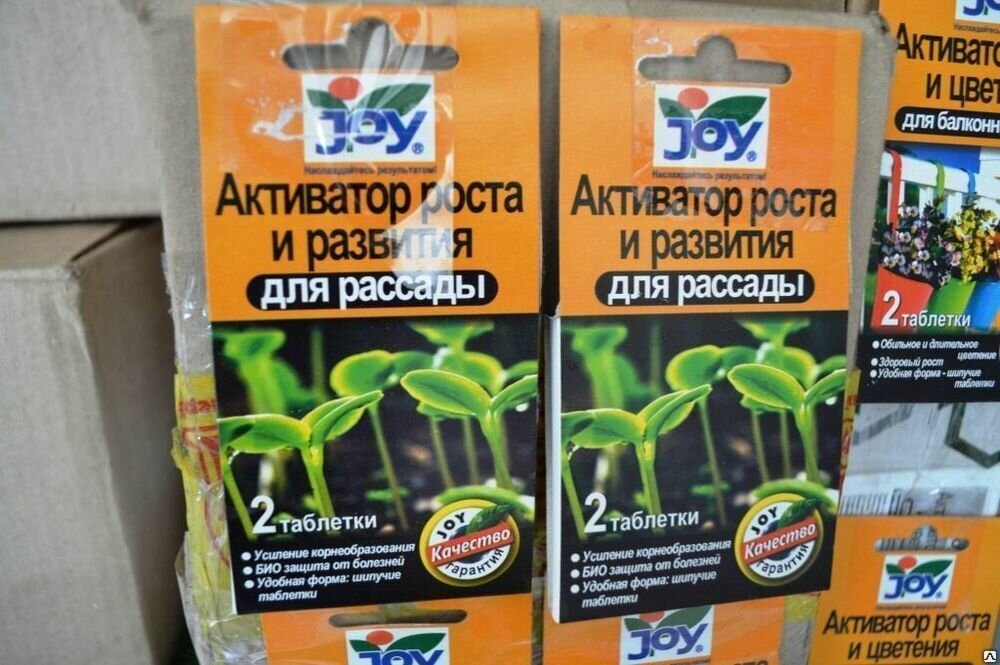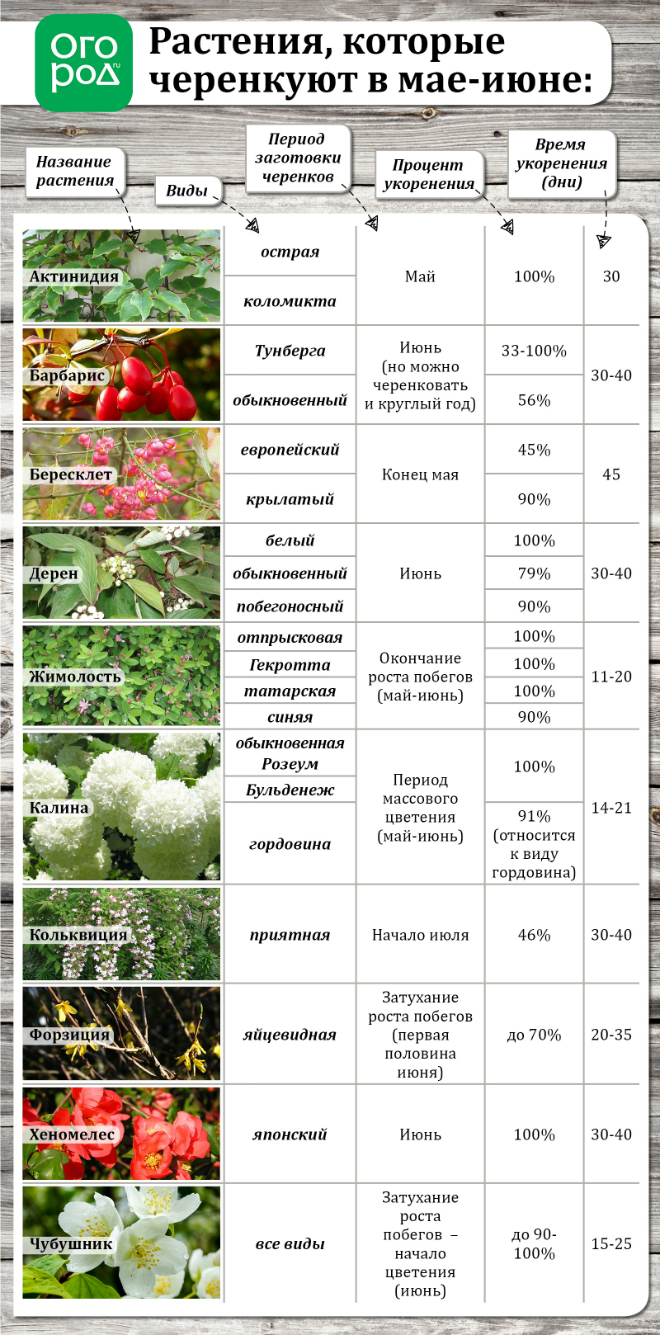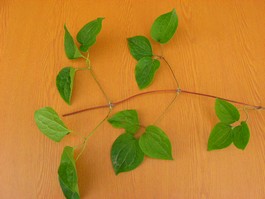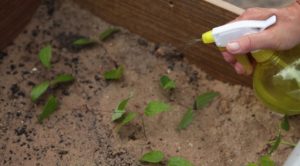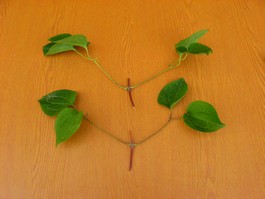Propagation by cuttings
Reproduction of clematis by cuttings is one of the quickest ways. Cuttings of clematis can be done in spring, summer and autumn. Each period has its own characteristics. Each of them is discussed in detail below.
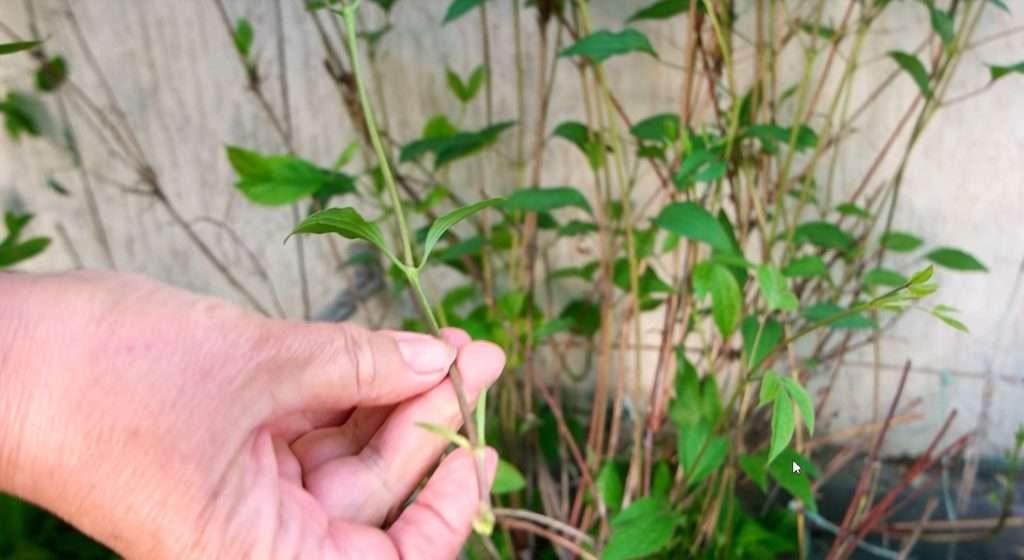
Propagation by cuttings
Reproduction of clematis in spring
In the spring, cuttings of vines are produced with green shoots. This process can be combined with spring pruning. The procedure is carried out in May or June in the southern parts, in June and July - in the Middle lane.
For grafting, you need to prepare: a knife, a pruner, soil, a cutting board, stimulants for the formation of roots, a container, a bag.
Detailed master class on how to make green cuttings:
- To obtain a cutting, it is worth choosing a plant whose age is from two years. It must be strong. No more than a third of the shoots can be cut off from the bush. The optimal shoot for rooting is from 90 cm in length, elastic and flexible. If there is no time to prepare the cutting for planting immediately after pruning, you can put it in water.
- Cutting cut. The stalk is cut from the central part of the shoot. The twig is laid out on the board. Then it is required to cut off with a knife from the bottom 2-3 cm from the internode in the middle part of the shoot. From below, the twig is cut 5 cm below the internode. The leaves on the sides are also removed.
- Container preparation. It is necessary to prepare the container and fill it with soil. It is best to prepare peat and sand in a 2: 1 ratio. The soil must be spilled with boiling water for disinfection.
- Cuttings processing. Cuttings are treated with a root stimulator according to the instructions. Then the shoots go deep into the soil by 0.3-0.5 cm and watered.
- Creation of the necessary conditions. Watering should be regular, room temperature 20-22 ° C. It is forbidden to keep the cuttings in direct sunlight.
If everything is done correctly, the roots will begin to grow within a few weeks. It takes one season to grow a stalk.
Note! In the autumn, the container is placed in a cellar for wintering.
How clematis reproduces by cuttings in summer
Some gardeners are wondering how to propagate clematis by cuttings in the summer. In summer, cuttings can be done in any month. However, those specimens that are cut at the end of summer will be much more difficult to take root. Cutting clematis in summer includes several stages. Each of them needs to be done carefully in order to get a beautifully flowering plant in the future. Description of how to cut clematis in summer:
- Soil preparation. It is not worth planting cuttings in purchased land from a store. The soil is prepared independently in two layers. The first layer is disinfected sand, the second is sand, peat and black earth in equal proportions. The soil should be loose and breathable.
- How to root clematis cuttings. It is necessary to cut off not very long and healthy shoots. The length should be 50 cm. Cutting is done from a bush that is four years old. The middle part of the shoot is cut. The outgrowth to be planted should have one or two buds. From the internode, the bottom should be 3 cm, and the top 2 cm. The cut is made at an angle of 45 °.
- Soak the cutting in the root formation activator solution for 5-6 hours.
- Disembark. This can be done in a plastic cup. Pre-holes are made in it. A cutting is planted so that the internode from below is half covered with soil. Sand is sprinkled on top and covered with plastic wrap.Every day it is necessary to remove the airing film and moisten the soil with a spray bottle.
Autumn reproduction of clematis by lignified cuttings
In the fall, grafting can be done as follows:
- Cut the cuttings 40 cm long.
- Sprinkle with copper sulfate.
- Soak the cuttings in a solution of potassium permanganate for disinfection.
- Trim cuttings. From the bottom, the cut is made 4 cm from the internode, the upper cut - by 1.5 cm.
- Soak in growth activators.
- In cups, dissolve half of the activated carbon tablet in the hydrogel and immerse the cuttings in the composition until the knot.
- Cover the glasses with cut off plastic bottles.
Rooting cuttings in plastic bottles
Rooting is done as follows:
- Hold the cut cuttings in the diluted root growth activator.
- Cut the plastic bottle in half.
- Fill the bottom of the cut-off bottle with soil.
- Plant the cutting in the soil.
- Put back the top of the bottle and wrap with tape.
- The bottle is buried in the ground up to the level of the filled earth.
- Two weeks later, the shoot is ventilated by unscrewing the plug for 20 minutes.
- After the emergence of shoots, the cork is removed.

How to root a vine in a bottle
We propagate clematis by cuttings
The answer to the question of whether clematis can be propagated by cuttings is positive. Moreover, a method such as cuttings makes it possible to obtain a large number of seedlings. The grafting process can be done at any time of the year, except in autumn. Consider the question of how to propagate clematis cuttings in more detail.
You can use both lignified and green cuttings. Reproduction by green cuttings differs from reproduction by lignified cuttings by the time of the cuttings. The process itself is not fundamentally different from the propagation of other shrubs. The stalk should be cut at an angle of 45 degrees, and there should be 2 knots on it. And you need to take it from the middle of the escape. It will be better for a plant if the cutting process is carried out in the fall.
The first priority when choosing the right planting material will be the selection of a suitable mother plant in the garden. It is best to consider clematis from the entire assortment, which will be more than 3 years old, since the shoots from such flowers will have the maximum survival rate. A simple way to propagate clematis is to separate the planting material in the budding phase of the culture, which is due to the presence of the maximum amount of active substances in the shoots.
It is best to cut off the shoot a little higher than the second bud from the ground. Each stalk should also have at least one node, which will contain two buds or leaves. In shoots with short internodes, it is more correct to cut cuttings with two buds. The cut should be made obliquely, below the very last knot, at least 3 centimeters. If the cut is carried out horizontally, then the indent from the knot should be in the range from 2 to 3 centimeters.
The optimal cutting length will be 50 centimeters.
Cut the cuttings from the middle part of the shoots: it is possible with two pairs of leaves (then we remove the lower one), or it is possible with one pair.
Cuttings
As a rule, gardeners are engaged in the propagation of clematis by cuttings in the summer. In principle, this can be done in the cold season (including using parts of the stems that have already partially lignified, and obtained as a result of pruning in winter), but in this case it is necessary to be able to work and grow seedlings in a heated greenhouse. Summer cuttings are rightfully called "green", since the planting material is obtained from non-lignified shoots of the current year.
Cutting clematis cuttings
As a "mother plant", it is preferable to use a bush that has been growing in a permanent place for at least 3 years, taking no more than a third of young shoots for reproduction. The stems are cut at the moment when clematis is going through the budding phase.At this time, plant tissues contain a large amount of biologically active substances. The specific timing of cuttings depends on the plant variety, as well as climatic conditions. In the middle lane, summer residents usually start the procedure no earlier than the beginning of June. Shortly before cutting the stems, clematis is fed on the leaves with a complex mineral fertilizer with a low content of nitrogen compounds (this contributes to the subsequent more active rooting of cuttings).
For reproduction, it is better to choose those shoots (or parts of them) on which there will be no flowers. The stem is considered ready for cutting if it does not break when bent.
To obtain planting material:
- choose suitable stems on the bush and cut them off just above the second bud from the ground;
- the tops are separated, and the shoots themselves are cut so that each part has one knot (that is, two buds and two leaves). If the internodes are short (4-5 cm each), the cuttings may have two nodes;
- from below, each stalk is cut obliquely (3-5 cm below the node), from above - horizontally (2-3 cm above the node). Sheet plastics are shortened by half. If there are two nodes, the bottom pair of leaves is removed completely.
In parallel, a place is being prepared for planting cuttings. Seedling boxes with a depth of about 30 cm (as in the photo) or glasses are used as containers. They are filled with a substrate consisting of two layers. The lower (15-20 cm) is a mixture of pure river sand with humus or peat in a 1: 1 ratio, the upper (3-5 cm) is sand or perlite. The soil in the container should be well moistened.
Cuttings can be rooted in boxes or glasses with a nutrient substrate
Then they act like this:
the lower sections of the cuttings are treated with a growth regulator ("Kornevin", "sodium humate", etc.), using the preparation according to the instructions on the package;
carefully take each stalk by the part left above the knot and dipped obliquely with the lower cut into the planting substrate until the knot (or the lower of the two knots) is 2-3 mm below the surface
Gently squeeze the substrate around the stem;
cuttings are planted in a common box at a distance of 5-8 cm from each other, or 2 pieces per glass. Landings are recommended to be spilled with a foundationol solution to protect against fungal diseases;
containers are installed in a greenhouse, in which a constant temperature (22-25 degrees) and high humidity are maintained
The structure must be ventilated and shaded daily from direct sunlight.
The rooting process usually takes 5-6 weeks. If clematis cuttings are carried out correctly, during this time each plant should have several roots. By the end of the rooting period, young bushes gradually "wean" from greenhouse conditions in order to prepare them for planting in open ground.
The percentage of rooting of "green" cuttings is quite high (up to 90%, depending on the variety of clematis)
Unfortunately, most summer residents do not have the opportunity to grow young plants in heated winter greenhouses. Therefore, already in the middle of summer, young clematis begin to be planted in open ground. In autumn, the plants are cut off (if they already have an aboveground part) and covered with a thick layer of mulch, and in winter they try to cover them with snow as much as possible. In this form, about 60% of seedlings successfully overwinter. By the spring, each already has about 10 roots 20-30 cm long. This is a full-fledged material, ready for relocation to a permanent place.
Cutting clematis
This breeding method is by far the easiest and fastest. Of course, before the clematis obtained from cuttings bloom in full force, you will have to wait several years, but a large number of plants with minimal effort and cost will fully compensate for the small delay. The percentage of rooting in clematis directly depends on the age of the shoots and the plant itself. Young clematis and annual shoots are used for cuttings.The bushes are chosen only from among the plants that have received careful care, strong, healthy, actively growing.
This vine can be rooted both green and woody cuttings. Usually, the rooting of clematis is carried out not in containers, but in the soil on a special bed - in a garden or greenhouse. With any method of cuttings, it is better to keep the shoots in a solution of a growth stimulator.
Cutting clematis shoots into cuttings is carried out in the spring, at the beginning or in the middle of summer, best of all - at the stage of budding (before flowering). For cuttings, cut the middle parts of the shoots, cutting them off at a height of about 30 cm from the soil. From the stems, sections of young shoots from 5 to 8 cm long with one node are cut (and if internodes are shorter than 4 cm, then with two nodes), the lower cuts are made at an angle of 45 degrees. Leaves on cuttings are charmingly shortened. No more than one third of the shoots can be cut from one clematis bush.
Cuttings of clematis are rooted in a moist peat-sandy substrate, under a hood, deepening the cuttings to the node or immersing the node itself by no more than 2-3 mm. Usually, the rooting process of lignified cuttings takes about one or two months. At this time, it is necessary to maintain not only stable light soil moisture, but also high air humidity, periodically spraying them with water and creating a "fog" under the hood. Airing is carried out regularly.
Young growing plants need to maintain a stable soil moisture. For the first winter, if clematis cuttings were not rooted in a greenhouse, they must be covered with a box or cap on top, covered with leaves and insulated with spruce branches. Without an air-dry shelter, plants will not be able to overwinter in the ground. A transplant to a permanent place is carried out only in the spring, observing the planting rules common to all clematis. But today they often recommend a strategy with growing plants for a whole year and planting in a permanent place only in the second year.
Lignified cuttings are cut in the fall, stored for the winter in containers with a substrate in cool and dark, and in the spring they are transferred to light and warm. In container clematis or clematis dug for the winter, shoots are cut in February-March. Autumn and spring cuttings are rooted in a stably moist substrate (spring cuttings are also under the hood, but controlling the air temperature - it should be as close to 15 degrees as possible). Rooting of woody cuttings lasts longer, takes about 2 - 3 months.
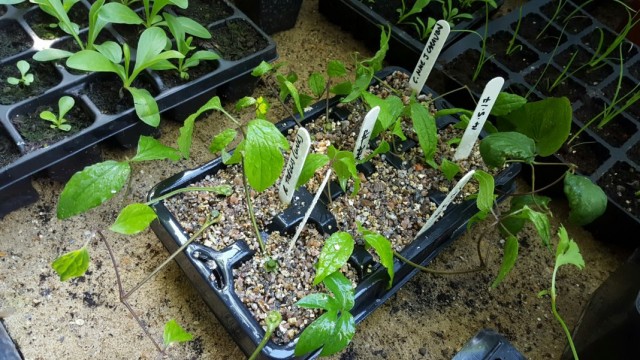 Rooting of clematis cuttings. cavershamjj
Rooting of clematis cuttings. cavershamjj
Reproduction of clematis by cuttings at different times of the year
Obtaining new clematis bushes can be carried out all year round: in spring and autumn, in winter and summer.
Cutting clematis in autumn
When pruning clematis in autumn, well-ripened and long shoots (about a meter in length) are selected. They must be twisted into a ring and buried in loose, moist soil (about 10 centimeters). This part of the soil will crust over after a while. As soon as this happens, sprinkle the clematis with a layer of foliage.
By the end of summer, a young clematis bush will grow
It is important to ensure that the earth does not dry out
Winter cuttings of clematis
For winter cuttings, the use of woody branches is characteristic. This is necessary in order to increase the chance of survival of cuttings in the cold winter, when the sunlight contains fewer nutrients.
On this topic:
BACK
FORWARD
1 in 60
The stalk should be small (less than twenty centimeters) so that it is convenient to make a small greenhouse for it. This will provide the young plant with warmth and moderate moisture.
Cuttings are less likely to be accepted and require more care.
Reproduction of clematis cuttings in spring
To get cuttings, you need to cut off a shoot of at least 70 centimeters from the bush. The upper part of the branch is not needed, since this is an unripe part of the shoot, the buds are not laid in the axils of the leaves here.
When cutting cuttings, about 7 centimeters are left. After that, the cuttings are placed in a solution of heteroauxin or root for half an hour. This stimulates the emergence of the root system. This makes clematis propagation by cuttings more efficient.
The earth can be loosened with a flat cutter, add humus so that the earth is fertile and soft. A groove is created, spilled with water. After the water is partially absorbed, the hole is partially covered with earth. Cuttings are inserted there up to the very sprouts.
How to properly cut clematis cuttings:
- Use a sharp knife. Pruning shears can crush and damage delicate, thin twigs. A sharp knife will not spoil the cuttings.
- Cut at a 45 degree angle. You need to cut the shoot obliquely, ideally at an angle of 45 degrees. With the help of such pruning, the area where the roots appear is increased.
- Pull back 1.5 centimeters. For a successful cut of cuttings, you need to retreat 1.2 - 2 centimeters from the nodule.
How clematis reproduces by cuttings in summer
Reproduction of this plant is very simple. There is no need to use additional materials.
On this topic:
BACK
FORWARD
1 of 31
A video about cutting clematis in the summer will tell you many important points that you should listen to and see with your own eyes. The video contains many tips for proper plant care. There are especially many nuances during the summer period. It is necessary to ensure that the cuttings do not dry out, like the earth in which they are located.
Cuttings are going well. By the next season, young and beautiful clematis grow.
Reproduction of clematis by cuttings in water
This method follows a similar principle.
It is worth considering several important factors that prevent possible errors (rotting of cuttings):
Clean container
It is very important that the container in which the cuttings will grow is perfectly clean. This is the main mistake after which the cuttings deteriorate and rot.
Quality cut
A smooth and neat cut is a guarantee of a well-developing root system. A bad cut can ruin the plant.
If you are interested in the question of how to grow clematis from a cuttings, then there is one good advice.
When rooting, plants secrete a liquid that contains natural root-forming substances. If the gardener has grown cuttings in water before, then it is good to add liquid from previous cuttings to new plants. This reduces the time for the formation of kalyus and the first grooves of the roots.
As soon as the grooves of the roots appear, the plant can be transplanted into the ground, or you can wait until a full-fledged root grows.
The stalk is transplanted into a small container, which needs to be covered with something on top to create an airtight package. You can take a bottle, cut it into two parts, in one of which you plant a stalk, and on the second you make small cuts from the bottom (thanks to this you can combine the bottles with each other). This is how clematis propagates by cuttings in water.
A small depression is made in the ground (it is not necessary to stick the cutting directly into the ground so as not to damage the kalyus), where the clematis is then placed.
Graft
Reproduction by grafts is relatively rarely used by amateur gardeners, since certain skills are needed for such work. In addition, it is necessary to be able to store materials and care for young plants in a warm room throughout the year.
The essence of the method is as follows: parts of clematis shoots (grafts), cut, as is done with "green" cuttings, are spliced with living pieces of rhizomes (rootstocks) so that the first as a result form their own root system. Roots of species (wild) or varietal clematis are usually used as rootstocks. They are harvested in advance and stored in moist peat or moss.Cuttings for rootstocks are cut and used as needed: in the summer - from plants living in open ground, and in the cold season - from specimens that are trying to grow indoors (in container culture) or in winter gardens.
Material for scions is prepared in the same way as for "green" grafting.
The technology of the procedure may be different, but all the techniques have one thing in common: the appropriately designed cuts on the handle and a piece of root are connected as tightly as possible, the alignment zone is tied with a strip of cellophane film. Then the seedling is placed in a nutritious soil so that the stock is completely immersed in it, and the junction with the scion is on the surface. The container with the plant is placed in a greenhouse and kept at a temperature of 18-22 degrees and a humidity of 85% until the roots appear above the graft site (that is, from the scion tissue). This usually takes about a month. With further growing, a self-rooted clematis seedling of the variety from which the cutting was taken for grafting is obtained.
Breeding clematis is easy. These plants have high plasticity and extraordinary growth activity. Therefore, even a novice gardener is able to get seedlings of decent quality from their bushes.









